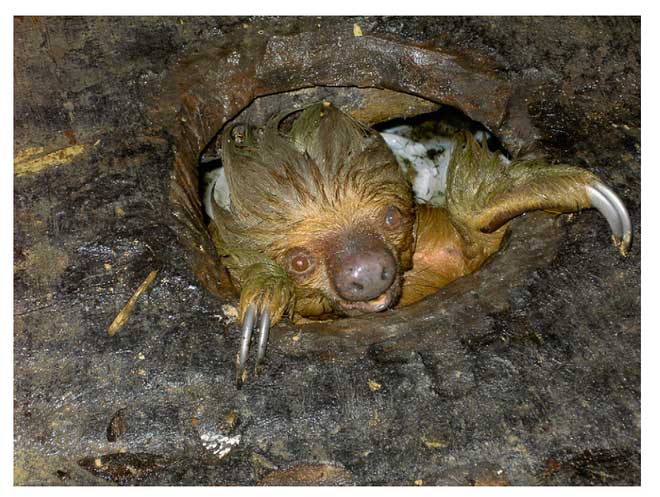Scientists have discovered that sloths sneak into their toilets, which they do horribly
We warn you not to read this story while eating. It contained science, bizarre but mixed with a feeling of disgust hidden behind the innocent, bewildered face of this South American sloth.
Two-finger sloth caught and caught photos while slowly peeking into the . a human toilet. He tried to sneak in here, not to freak out or harm anyone, but he came to the party.

Scientists have discovered that sloths sneak into their toilets, which they do horribly.
This story takes place in the Amazon rainforest in northeastern Peru, home to the two-finger sloth (Choloepus didactylus) . These beautiful sloths spend most of their lives hanging on trees. They are so lazy that the algae will attach from the trunk to their fur, forming a magical green color.
Sloths eat grass, leaves, flowers, bark or shoots of young plants. But that was what happened back in 1984, when a research station called Estación Biológica Quebrada Blanco (EBQB) was built here. Scientists come and go, rotating their studies in EBQB since 1997. Each time, they leave their . dung.
Of course, the EBQB research station has a toilet, even though it is just a simple squat toilet, dumping faeces directly underground. And this is also where scientists discovered a horrific truth has never been known before.
One night in early November 2001, a scientist went to the toilet and found a sloth hanging on a wooden beam above. The astonishment is that this sloth is eating. It's not flowers, leaves, grass, plants, sloths are eating scientists' feces .
"He scooped up a slimy mixture of stool, urine and toilet paper with one hand, and then sucked it coolly," a team of researchers later wrote in a 2011 report. many people gather around the latrines to watch this bizarre behavior, the sloth emerging from it and climbing the nearest tree. "
Scientists think it's just a sick sloth, behaving in a way that other normal sloths don't have. But they were wrong. This sloth returns, and there are other sloths joining the party with it. In total, the scientists recorded 26 visits of sloths eating faeces .
There are sloths going on their own, but at least one mother sloth led her child clinging to its toilet. They always come at night - in keeping with this species' night-eating habit - and often when it rains. They appear in wet form, arrive at the party and then slowly leave, returning to the forest canopy.


The sloths come until it rains, and a mother sloth takes her children along.
The question with this unprecedented phenomenon: Why do sloths - animals that have never eaten anything other than plants - eat human feces?
The clue brought scientists back to study the habits of faecal animals, in a group called coprophagia . They include rodents such as rabbits and to a lesser extent dogs, ponies, piglets and primates.
Fecal feeding habits have also been observed in cave salamander species. In general, the reason these animals come to this strange food source is a nutrient or a means of digestion in their own feces or other species.
For example, rabbits cannot absorb nutrients effectively the first time, so they must eat their own faeces to digest it twice. Female koalas feed their faeces at the time they transition from suckling to eating eucalyptus leaves. And the mother's koala's stool helps its children adjust to the new diet.
Cave salamander can eat bat manure as a backup food source when all other foods become scarce.
So researchers believe there may be some nutrients or minerals in their toilets that are appealing to sloths. Sodium is an example. A leafy diet often results in a deficiency of sodium or even protein. That protein can be found in the worms, which are also eating human feces.

Sloths are known to only eat grass, leaves, flowers, bark or shoots of young plants.
Despite this, the fact that the two-finger sloths in the Amazon break their normal habits to eat human waste carries a lot of risk to their own species. Human feces can contain many harmful bacteria and parasites, which can spread and affect the lazy population.
Therefore, researchers put an end to their illegal toilet raids. In 2007, they re-fenced the latrine with wire mesh and the sloths could no longer sneak in.
Honestly, that's the best that scientists can do. They published their study in the journal Mammalian Biology, showing how the presence of humans in a pristine forest area can affect animal populations.
- Why are you lazy . lazy? The reason turned out to be more interesting than we thought
- The laziest animal in the world
- The sloths but diligent
- The panoramic view of the toilet bowl is on every grain
- The reason for ice cold to male toilet toilet is not known
- Special toilets in China
- Discovered many giant animals living in the plateau
- Why does modern Japan still exist squatting?
- The largest collective pit of the planet
- Birth history of sanitary equipment
- Birds sneak through narrow slots like fighters
- When coming to Japan, do not go to the bathroom during the bath, why?
- Sloths are not lazy
- Does the tap water contain more bacteria than the toilet?
 Animal 'suffering' after hibernation
Animal 'suffering' after hibernation Why do goats climb well?
Why do goats climb well? Scientists were surprised to see chimpanzees eating turtles
Scientists were surprised to see chimpanzees eating turtles Giant catfish died deadly due to drought in Thailand
Giant catfish died deadly due to drought in Thailand